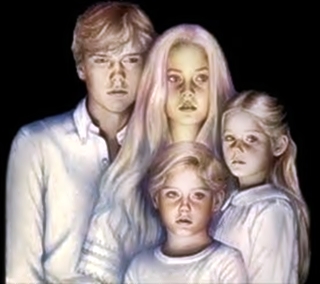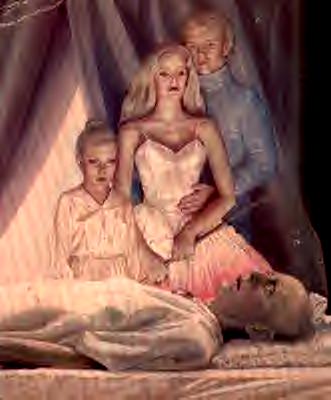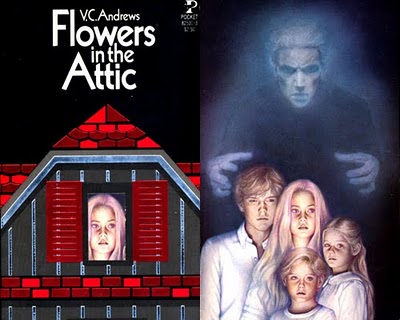SPOILER ALERT: if you’ve managed to avoid this book for the past 35 years.
Because of Lifetime’s new movie adaptation of Flowers in the Attic, I got to thinking about this ridiculous book. V.C. Andrews’ best-selling “novel” of bad parenting, greed, whips and a love so taboo it dare not take a DNA test, has endured for 35 years as a nostalgia-fueled oddity. Back in the day, we would read the book – the scary cut-out paperback cover version – aloud on the school bus, laughing and gasping at the campy, hilarious, thrilling tripe. Consdering the book snob I was, it’s amazing that I stooped to reaing this trash, I knew it was really scraping the bottom of the barrel. But, in the mind of a pre-teen, Flowers in the Attic was kind of like watching a more sinister version of General Hospital.
The 1979 “novel” told the sad tale of four very blond siblings who get locked up in an attic for three or four years, and a series of increasingly terrible events take place, including but not limited to: the aforementioned whipping, hair tarring, starving, poisoning by arsenic doughnut, and incestual sex (between the older ones, although the younger ones would have gotten around to it, had the boy not been murdered by arsenic by his mom). It rolled tortured gothic drama, over-arching pseudo-Victorian syntax, orphan fantasy, and uniquely framed teenage rebellion and yeah, a heapin’ helping of incest (Cathy is raped by Christopher the first time. Later, she is fully on board), into a paperback package that sold 40 million copies. V.C. Andrews was (she’s been dead for 20 years but few seemed to notice as V.C. Andrews never missed a beat, under the tutelage of a ghostwriter), a terrible writer. The book is full of puerile and ridiculous dialogue and plot holes, but the fact that this story can still provoke such strong emotions in so many of my ilk is a testament to something.
Only in a twisted, gothic horror, claustrophobic emotional hothouse environment could a character’s rape of his own sister be cast in an even slightly sympathetic light. Teens tweens and adults alike gobbled up Flowers on the Attic and wolfed down the rest of the series because they wanted to see them “get back together.” So Andrews was at least effective at that. They found the story of blond, “Dresden-doll” family to be a compelling story of a family’s betrayal and heartbreak, love and revenge. 12-year old Cathy Dollenganger is beeeeautiful with loooong blooooonde hair, blue eyes and is an aspiring ballerina,who is her father’s faaaaavorite.

Her siblings are her older brainy brother Chris, and little twins Cory and Carrie – THEIR NAMES ALL START WITH C’S. Their parents, Christopher and Corrine, are possessed of a shattering beauty as well as in icky, overarching sensuality. When we meet the Dollenganger clan, they are in the waning days of their picture-perfect life. Corrine is not just gorgeous, she is a model of old-world womanity. Her only job was to maintain her great her beauty, and she instructs little Cathy on how to groom and coif herself to keep a husband titillated:
On Fridays, Momma spent half the day in the beauty parlour having her hair shampooed and set and her fingernails polished, and then she’d come home to take a long bath in perfumed-oil water. I’d perch in her dressing-room, and watch her emerge in a filmy negligee. She’s sit at her dressing-table to meticulously apply make-up. And I, so eager to learn, drank in everything she did to turn herself from just a pretty woman into a creature so ravishingly beautiful she didn’t look real. The most amazing part of this was our father thought she DIDN’T wear makeup! He believed she was naturally a striking beauty.
The Dresden dolls are torn apart when blond dad is killed in a car accident and blond mom sacrifices her own children by locking them in an attic of her parents enormous, grim estate to get a massive inheritance she finds she loves more than her own kiddos. At the beginning, they are just supposed to hang out in the attic for a few days until grandfather is prepared to meet them, at which point charming him with their blond perfection, so that old granddad will write them into the will, and everyone will live happily and blond for ever after.
Everyone outside of the Doll’s immediate family is NOT BEAUTIFUL. They are, in fact, UGLY. Consider the grandmother:
Her nose was an eagle’s beak, her shoulders were wide, and her mouth was like a thin, crooked knife slash. Her dress, a grey taffeta, had a diamond brooch at the throat on a high, severe neckline. Nothing about her appeared soft or yielding; even her bosom looked like twin hills of concrete.
Miss Minchin with a dirty mind! She looks upon her pretty grandkids as devil’s spawn, bad seeds of an incestuous coupling (apparently her daughter and her now deceased husband were cousins). She instructs them to stare at the Bible to absorb the “purity of the Lord and his ways”.
“if I ever catch boys and girls using the bathroom at the same time, I will quite relentlessly, and without mercy, peel the skin from your backs.”
At first, naturally, I was jealous! The attic was cool! It was cozy! The kids didn’t have to go to school or move around very much! They get to eat jelly sandwiches and fried chicken delivered to their door! Mom buys them expensive dresses and games and toys. And soon they will be rich! Wait it out, don’t go to school, play it out and soon they’ll be rich! And, as Christopher points out, they have all the time in the world to READ! They read Tom Sawyer, Jude the Obscure, Wuthering Heights, Lorna Doone and King Arthur. Cathy gets hooked on Shakespeare, Eugene O’Neill, and “anything that was dramatic, fanciful and fraught with tempestuous emotions.” Christopher is more a Sherlock Holmes fan! It’s heaven! They just have to hang out in that attic for a few days. Alas, the long series of days stretch into weeks and then FOUR YEARS. FOUR YEARS. Four years later, the kids have grown scraggly and thin and spindly and pale as the paper flowers hanging in the attic, bleached by the sun.

It’s really pretty fucked up, the extent to which V.C.’s books trivialize incest. Sure, Chris and Cathy start out their romance (bromance?) with a rape, but then it becomes an actual relationship. There’s something profoundly peculiar in her books, that you don’t really see in other incest narratives. Byron’s Manfred, a gothic villain in that he nursed a dark secret – incest….he s at least riddled with self disgust and sexual guilt over whatever he did with his twin sister that caused her (possible) suicide. Or Jane’s Eyre’s psychic conflict over her relationship with Rochester, Or the Tulliver siblings in The Mill on the Floss, who drown in each other’s passionate embrace, carried into death. I mean, even with the attic as an excuse, and even though Cathy wrestles a little bit with the whole thing, there’s some perverse attempt to make this seem *okay* – that his unstoppable passion is inevitable, given puberty, the attic, her blond beauty, and all the romantic novels they’ve been reading – that I’ve never been able to wrap my head around.
Still, the far worse sin is the fact that the most popular books today – some 35 years after Flowers in the Attic – are in the Young Adult category, and read by 30 and 40-year old people. Why forty-somethings would be interested in such an illiterate, sanitized version of sex and danger as fucking Twilight is absolutely incomprehensible. It’s worth somebody writing a dissertation about, at least. Guilty pleasures I have no problem with, but when the stuff you read is meant for teenagers,… I tend to look at judge. Flowers in the Attic‘s crossover from teen-to-adult zeitgeist was unique for its time, and I blame it for creating the template for the cross-generational young adult blockbuster. It was the Twilight for my generation, and for that I will never forgive it.
Now I’m going to go take a shower.


